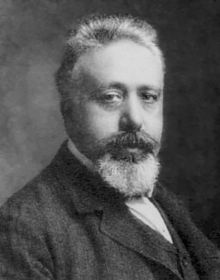Vito Volterra facts for kids
Quick facts for kids
Vito Volterra
|
|
|---|---|

Vito Volterra
|
|
| Born | 3 May 1860 |
| Died | 11 October 1940 (aged 80) |
| Nationality | Italian |
| Alma mater | University of Pisa |
| Known for | Volterra integral equation Volterra operator Lotka–Volterra equations Volterra lattice |
| Awards | ForMemRS |
| Scientific career | |
| Fields | Mathematics |
| Institutions | University of Turin |
| Doctoral advisor | Enrico Betti |
| Doctoral students | Paul Lévy Joseph Pérès |
Vito Volterra (born May 3, 1860 – died October 11, 1940) was a famous Italian mathematician and physicist. He is well-known for his work in mathematical biology, which uses math to understand living things. He also made important discoveries about integral equations, a type of math problem. Volterra was one of the people who helped start a field of math called functional analysis.
Contents
Vito Volterra's Life Story
Vito Volterra was born in Ancona, a city that was then part of the Papal States. He came from a family that was not wealthy. His father, Abramo Volterra, died when Vito was only two years old.
His family later moved to Turin and then to Florence. In Florence, Vito studied at technical schools, where he showed a lot of talent for mathematics.
Early Education and University
Vito went to the University of Pisa. There, he was greatly influenced by his teacher, Enrico Betti. In 1883, when he was just 23, Volterra became a professor of rational mechanics at the same university.
He quickly began to develop his ideas about "functionals." This work led him to study integral and integro-differential equations. These are advanced types of equations used to solve complex problems in science and engineering.
Moving to New Universities
In 1892, Volterra became a professor of mechanics at the University of Turin. Later, in 1900, he moved to the University of Rome La Sapienza to teach mathematical physics.
Volterra grew up during a time when Italy was becoming a unified country. He was a very patriotic person, just like his mentor Betti. In 1905, the king of Italy, Victor Emmanuel III, made him a senator.
Contributions During World War I
Around 1905, Volterra also started working on the theory of dislocations in crystals. This work later became very important for understanding how strong and flexible materials are.
When World War I started, Volterra was in his 50s. He joined the Italian Army and helped develop airships. He came up with the idea of using safe helium gas instead of dangerous, flammable hydrogen. He also helped organize how helium was made.
Math and Biology
After World War I, Volterra became very interested in using math to study biology. He built on the work of another scientist, Pierre François Verhulst.
One of his most famous contributions from this time is the Lotka–Volterra equations. These equations help scientists understand how populations of different animals, like predators and their prey, change over time.
Speaking at Math Conferences
Vito Volterra was a very respected mathematician. He was the only person to give a main speech at the International Congress of Mathematicians four times. These speeches happened in 1900, 1908, 1920, and 1928.
Standing Up for What's Right
In 1922, Volterra disagreed with the Fascist government led by Benito Mussolini. In 1931, the government made all professors take an oath of loyalty. Volterra was one of only 12 out of 1,250 professors who bravely refused to sign it.
He believed that ideas and truth last longer than governments. He once wrote, "Empires die, but Euclid’s theorems keep their youth forever." Because he refused to sign the oath, he had to leave his university job and his memberships in scientific groups. He spent his last years living mostly outside Italy. He returned to Rome just before he passed away.
In 1936, he was made a member of the Pontifical Academy of Sciences. He died in Rome on October 11, 1940, and is buried in the Ariccia Cemetery.
Volterra's Family
In 1900, Vito Volterra married Virginia Almagia, who was his cousin. Their son, Edoardo Volterra (1904–1984), became a well-known historian who studied Roman law.
Vito also had a daughter named Luisa Volterra. She married a man named Umberto d'Ancona. Umberto showed Vito some interesting information about fish populations in the Adriatic Sea. During the war, there was less fishing, and the number of fish that ate other fish (predators) increased. This made Vito very interested in using math to study how different animal species interact. The next year, he published his own analysis of these fish populations.
See also
 In Spanish: Vito Volterra para niños
In Spanish: Vito Volterra para niños
- Volterra (crater)
- Volterra's function
- Lotka–Volterra equation
- Smith–Volterra–Cantor set
- Volterra integral equation
- Volterra series
- Product integral
- Volterra operator
- Volterra space
- Volterra Semiconductor
- Poincaré lemma

